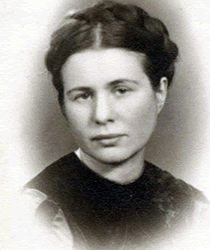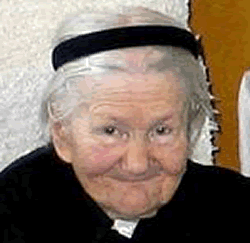
Irena Sendler
From Wikipedia, the free encyclopedia
Irena SendlerIrena Sendler (also called Irena Sendlerowa in Polish
language) (born 15 February 1910 in Warsaw). Polish social worker.
During World War II she was an activist of Polish Underground and
Polish anti-Holocaust resistance in Warsaw, where she helped to save
about 2500 Jewish children from the Warsaw Ghetto by providing them
false documents and hiding places in individual and group children
houses out of the Ghetto.
WWII resistance activities
During the World War II German occupation of Poland, she lived in
Warsaw while working for the city's Social Welfare Department. She
started helping Jews long time before the Warsaw Ghetto was
established. Helping Jews was very risky — in German-occupied Poland,
all household members were punished by death if a hidden Jew was found
in their house. This was the most severe legislation in occupied
Europe. In December of 1942, the newly created Zegota, a council to
aid Jews, nominated her (under her cover name Jolanta [1]) to head its
children's department. As an employee of the Social Welfare
Department, she had a special permit to enter the Warsaw Ghetto, where
she wore a Star of David as a sign of solidarity with the Jewish
people and so as not to call attention to herself.
She cooperated with the Children's Section of the Municipal
Administration, linked with the RGO (Central Welfare Council), a
Polish Relief Organization tolerated under German supervision. She
organized the smuggling of Jewish children from the Ghetto, carrying
them out, and placing them with either Polish families, the Warsaw
orphanage of the Sisters of the Family of Mary, or Catholic convents
such as the Sisters Little Servants of the Immaculate Conception of
the Blessed Mary (L.S.I.C.) at Turkowice [2] and Chotomow [3]. She
kept lists of the names, hidden in jars, in order to keep track of
original and new identities.
Arrested in 1943 by the Gestapo, she was severely tortured and
sentenced to death. Zegota saved her by bribing the German guards on
the way to her execution. Officially, she was listed on public
bulletin boards as among those executed. Even in hiding, she continued
her work for the Jewish children.
Post-WWII awards
In 1965, she was recognized by Yad Vashem as a Righteous Among the
Nations, which was confirmed in 1983 by the Israeli Supreme Court.
On 10 October 2003, Irena Sendler received the Order of the White
Eagle, Poland's highest civilian decoration. She also was awarded the
Commanders Cross by the Israeli Institute.
On 14 March 2007, Sendler was honoured by Poland's senate. Polish
President Lech Kaczynski stated that she "can be justly named for the
Nobel Peace Prize" (nominations are supposed to be kept secret,
though). At age 97, she was unable to leave her nursing home to
receive the honour, but she sent a statement through Elzbieta
Ficowska, whom Sendler saved as a baby.
The "Life in a Jar" project
In 1999 Norm Conard, a high school teacher from Pittsburg, Kansas,
encouraged four students to investigate the life of Irena Sendler. As
a result of their findings, the students created a play, entitled
"Life in a Jar" (after her hiding place for documents), which
presented the heroic acts of Mrs. Sendler. As of November 2006, there
were over 200 performances: at first in Kansas, then all around the
United States and ultimately in Europe.
References
Anna Mieszkowska, Die Mutter der Holocaust-Kinder, DVA 2006, ISBN
3-421-05912-8 [4]
Irene Tomaszewski & Tecia Werblowski, "Zegota: The Council to Aid Jews
in Occupied Poland 1942-1945", ISBN 1-896881-15-7, Price-Patterson
External links
Irena SendlerIrena Sendler at yadvashem.org
http://www1.yadvashem.org/righteous/bycountry/poland/irena_sendlar.html
Irena Sendler at holocaustforgotten.com
http://www.holocaustforgotten.com/sendler.htm
IrenaSendler.org Project
Holocaust Rescuers Bibliography
"Irena Sendler for Nobel Peace Prize" initiative
http://fzp.jewish.org.pl/nobel_eng.html
Pole who saved WWII Jews honoured, BBC News Online, 14 March 2007
http://news.bbc.co.uk/1/hi/world/europe/6448603.stm
I'm no hero, says woman who saved 2,500 ghetto children, Guardian
Online, 15 March 2007
Retrieved from "http://en.wikipedia.org/wiki/Irena_Sendler"
from Lili Haber <lili@lyhaber.com>
Irena Sendler, Warsaw, February 2007, aged 97

IRENA SENDLEROWA
has passed away
Today (12.05.2008) Irena Sendler died at 8:45 in a Warsaw hospital on P?ocka
The hero of the time of the Holocaust is gone.
In extreme conditions, her attitude, conduct,
and actions became an unattainable model
of humanity, courage, and people's solidarity.
She saved 2500 Jewish children from the Warsaw Ghetto.
May She rest in peace
During World War II she was an activist in the Polish Underground and the ?egota Polish anti-Holocaust resistance in Warsaw. She helped save some 2,500 Jewish children from the Warsaw Ghetto by providing them false documents and sheltering them in individual and group children's homes outside the Ghetto
During the World War II German occupation of Poland, Sendler lived in Warsaw (before that she lived in Tarczyn) while working for the city's Social Welfare Department. She started helping Jews a long time before the Warsaw Ghetto was established. Helping Jews was very risky — in German-occupied Poland, all household members were punished by death if a hidden Jew was found in their house. This was the most severe punishment compared to those applied in other occupied European countries.
In December 1942, the newly created Children's Section of the ?egota Council for Assistance to the Jews, a council to aid Jews, nominated her (under her cover name Jolanta[3]) to head its children's department. As an employee of the Social Welfare Department, she had a special permit to enter the Warsaw Ghetto, to check for signs of typhus, something the Nazis feared would spread beyond the ghetto.[4] During the visits, she wore a Star of David as a sign of solidarity with the Jewish people and so as not to call attention to herself.
She cooperated with the Children's Section of the Municipal Administration, linked with the RGO (Central Welfare Council), a Polish Relief Organization tolerated under German supervision. She organized the smuggling of Jewish children from the Ghetto, carrying them out in boxes, suitcases and trolleys.[2] The children were placed with Polish families, the Warsaw orphanage of the Sisters of the Family of Mary or Roman Catholic convents such as the Sisters Little Servants of the Immaculate Conception of the Blessed Mary[5] at Turkowice and Chotomów. Some were smuggled to priests in parish rectories where they could be further hidden. She kept lists of the names, hidden in jars, in order to keep track of their original and new identities.
Arrested in 1943 by the Gestapo, she was severely tortured and sentenced to death. The ?egota saved her by bribing the German guards on the way to her execution. She was left in woods, unconcious and with broken arms and limbs.[2] Officially, she was listed on public bulletin boards as among those executed. Even in hiding, she continued her work for the Jewish children.
Postwar awards
In 1965, she was recognized by Yad Vashem as a Righteous Among the Nations, which was confirmed in 1983 by the Israeli Supreme Court. She also was awarded the Commanders Cross by the Israeli Institute.
In 2003, Pope John Paul II sent a personal letter to Sendler, praising her altruistic wartime efforts.
On 10 October 2003, Irena Sendler received the Order of the White Eagle, Poland's highest civilian decoration. Sendler was also awarded the Jan Karski Award "For Courage and Heart", which is given by the American Center of Polish Culture in Washington.
On 14 March 2007, Sendler was honoured by Poland's Senate. Polish President Lech Kaczynski stated that she "can be justly named for the Nobel Peace Prize" (nominations are supposed to be kept secret, though). At age 97, she was unable to leave her nursing home to receive the honour, but she sent a statement through Elzbieta Ficowska, whom Sendler saved as a baby.
Sendler was the last survivor from the Children's Section of the ?egota Council for Assistance to the Jews, which she headed from January 1943 until the end of World War II.
Nobel nominee
Sendler was a nominee for the Nobel Peace Prize in 2007, but lost out to Al Gore, former Vice President of the United States.
Life in a Jar
In 1999, Norm Conard, a high school teacher from Pittsburg, Kansas, encouraged four students at the Uniontown, Kansas, school where he taught to investigate the life of Irena Sendler.
Based on their findings, the students created a play, Life in a Jar (after her hiding place for documents), which re-enacted Sendler's heroic acts. As of March 2008, there had been over 240 performances: first in Kansas, then all around the United States, in Canada, and finally in Europe.
In 2006, in Kansas, March 10 was declared Irena Sendler Day.